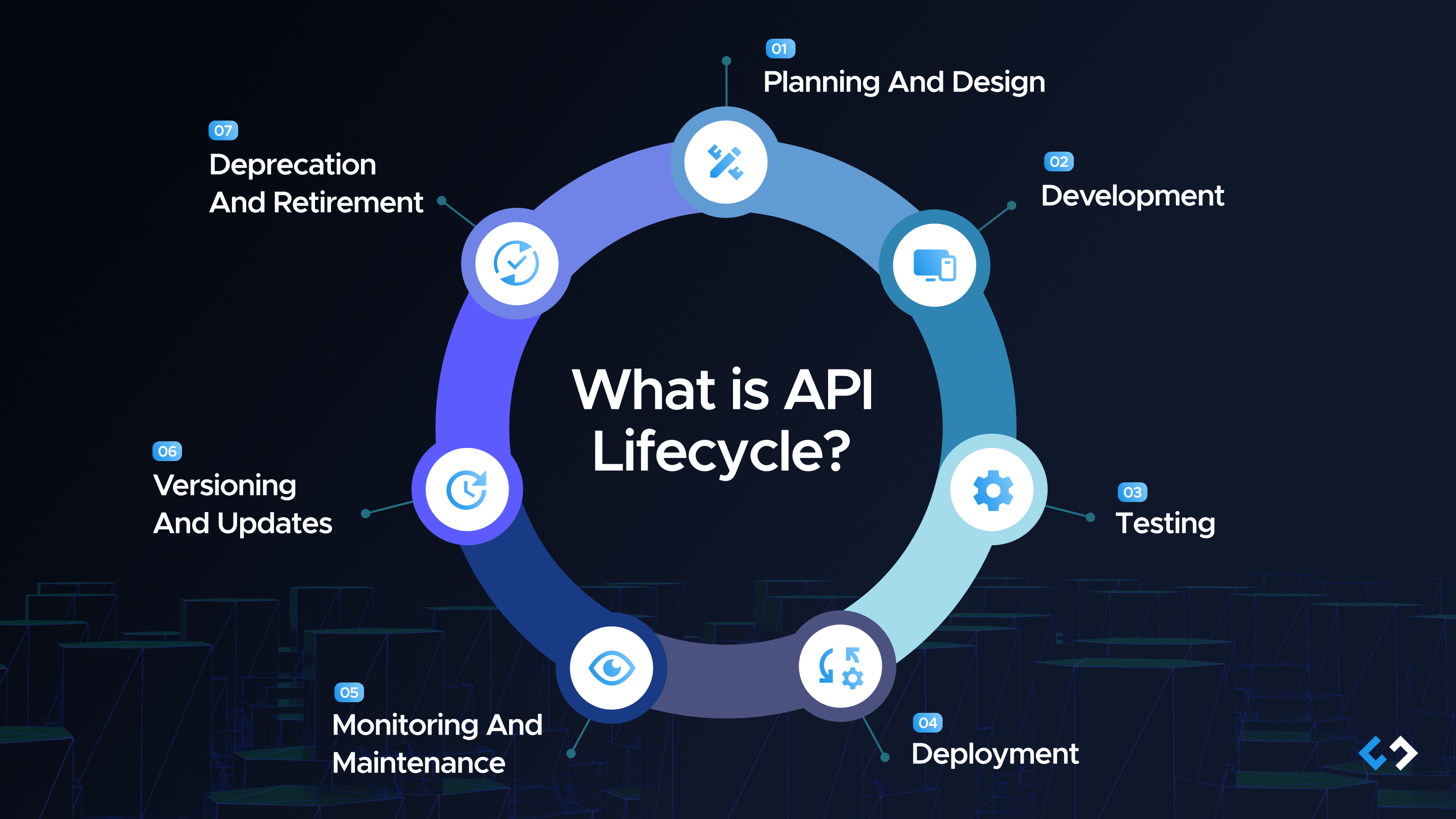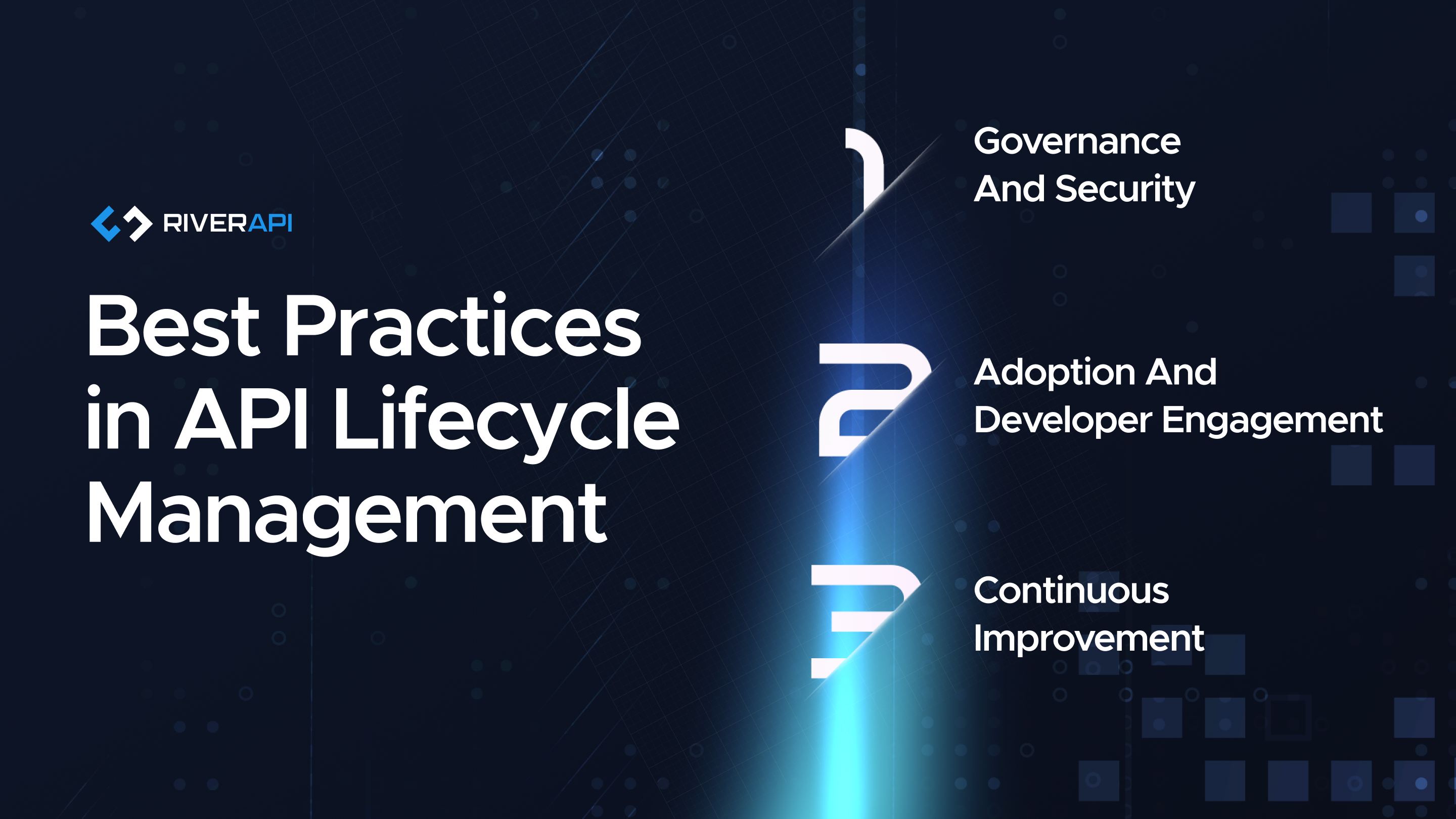Understanding the API Lifecycle
The API lifecycle is the structured journey an API takes from conception to retirement. A well-managed lifecycle ensures APIs are designed efficiently, deployed reliably, monitored continuously, and retired safely. Organisations that understand and implement API lifecycle management can improve developer experience, maintain high-quality APIs, and reduce risks like downtime, security breaches, or inconsistent performance. Full lifecycle management combines strategy, design, development, testing, deployment, monitoring, and management policies into a cohesive process, allowing APIs to deliver consistent value across internal and external stakeholders.
What is the API Lifecycle?
The API lifecycle refers to all phases an API goes through, from initial planning to eventual decommissioning. Key points include:

- Structured Process: Each stage has defined goals, from design to retirement, ensuring APIs meet business and technical requirements.
- Consistency and Quality: Following a lifecycle prevents fragmented APIs, reduces sprawl, and ensures every API functions as intended.
- Visibility for Teams: Developers, QA engineers, product managers, and operations teams gain a clear roadmap for managing APIs, increasing collaboration and reducing errors.
- Strategic Impact: A mature lifecycle connects APIs to business strategy, supporting revenue streams, integrations, and digital services effectively.
Full API Lifecycle Management
Full lifecycle management encompasses end-to-end oversight, ensuring APIs remain reliable, secure, and performant. It includes:
- Planning and Regulation: Setting objectives, defining security policies, and establishing implementation strategies.
- Development Oversight: Coordinating coding standards, versioning, and API contracts to maintain compatibility.
- Testing and Validation: Continuous functional, performance, load, and security testing to catch issues early.
- Deployment and Monitoring: Using API gateways and platforms to deploy, monitor performance, and enforce security policies.
- Retirement Strategy: Proper decommissioning to avoid deprecated endpoints affecting consumers while maintaining documentation for legacy use.
Role of API Management Platforms
API management platforms are essential for executing full lifecycle strategies efficiently. Their contributions include:
- Regulation and Policy Enforcement: Enforce authentication, rate limiting, quotas, and access control to secure APIs.
- Monitoring and Analytics: Provide dashboards and metrics to track usage, latency, errors, and implementation trends.
- Developer Experience: Offer portals, SDKs, and interactive documentation to support external and internal developers.
- Scalability and Integration: Platforms like AWS API Gateway, Apigee, or Azure API Management help manage traffic, deploy updates safely, and integrate with CI/CD pipelines.
- API Portfolio Management: Maintain a catalogue of APIs, track versions, and manage dependencies across teams or applications.
The Eight Stages of the API Lifecycle
The 8 stages of the api provide a structured framework to ensure that APIs meet technical, business, and security requirements. Effective lifecycle management is the process that helps organisations maintain high-quality APIs throughout development, release, and retirement. By following these stages, teams can manage every aspect of the API, ensuring it is stable, performant, and ready for both in-house and third-party API producers to reach.
Planning and Strategy
The first stage involves defining objectives, target audiences, and the business value of each API. Organisations must give their API programs clear goals, including regulation policies, security considerations, and integration strategies. Strategic planning ensures that every aspect of the api aligns with organisational priorities and sets a roadmap for successful implementation of the api.
Design and Specification
In this stage, the strategy is translated into technical design. Designing an api includes endpoint planning, request and response structure, authentication, and adherence to standards such as REST, SOAP, GraphQL, or gRPC. Proper specification also defines how api code is structured, and ensures practices for shaping the surface of the API are followed for clarity, consistency, and maintainability.
Development
The development stage focuses on building the API according to the specifications. Api is built using clean, maintainable API code by a dedicated API development team. This stage involves unit testing, integration checks, and collaboration to ensure that the API functions correctly. By implementing automated checks and versioning, organisations can guarantee that api is stable and supports deploying the api efficiently.
Testing
Api testing is performed to validate functionality, performance, and security before release. Functional, load, regression, and security tests confirm that api provides a reliable service. Automated and manual tests ensure api is ready for production while minimising the risk of errors. Testing occurs at multiple levels to cover all scenarios and ensure every aspect of the api behaves as expected.
Deployment
Releasing APIs into production involves careful orchestration. Using api gateways and staged release techniques, teams ensure smooth rollout. Deploying the api requires monitoring, access control, and compliance verification. Proper release ensures that api is stable and immediately usable by api producers, reaching in-house and third-party developers.
Publication and Documentation
Publishing an API makes it discoverable and usable. Comprehensive documentation, interactive consoles, and SDKs help developers understand capabilities. Well-documented APIs allow organisations to give their api to teams and partners, enhancing adoption and usage. This stage ensures api is ready for implementation via an api and supports effective API integration.
Monitoring and Management
Continuous oversight is critical across the API lifecycle. API monitoring tracks performance, usage, errors, and latency. Policies are enforced to maintain security and reliability, ensuring api provides consistent functionality across the api lifecycle. Teams can optimise performance and address issues proactively, keeping the entire api healthy and high-performing.
Retirement and Decommission
APIs eventually reach the end of their useful life. Proper decommissioning removes deprecated endpoints, archives documentation, and preserves the integrity of the api portfolio. Following structured retirement practices ensures each aspect of the api is responsibly managed, reducing technical debt while supporting ongoing innovation.
Best Practices in API Lifecycle Management
Effective lifecycle management is the process that combines governance, security, and adoption to maximise API value. Heavily in api lifecycle management, organisations must implement consistent policies, maintain performance, and engage developers.

Governance and Security
Clear policy definition, access control, compliance, versioning, and security testing are critical. Strong governance ensures that api is stable, secure, and meets organisational standards throughout its phase of the api lifecycle.
Adoption and Developer Engagement
Providing developer portals, tutorials, examples, and responsive support ensures api producers reach in-house and third-party teams. Encouraging feedback, community collaboration, and visibility helps organisations give their api programs maximum implementation.
Continuous Improvement
Monitoring, analytics, and iterative updates allow APIs to evolve in response to usage and performance data. Performance optimisation, feedback integration, and lifecycle reviews ensure api is ready to meet growing demand. Following best practices ensures each aspect of the api is maintained effectively, and implementing the api delivers long-term value.
Tools and Platforms for Managing the API Lifecycle
Leveraging the right tools and platforms is essential for a well-defined api lifecycle. These solutions help organisations manage APIs from creation to retirement while ensuring security, performance, and usability across production environments. Effective tools reduce manual effort, improve collaboration, and provide capabilities for both public APIs and internal systems. By centralising management, teams can streamline api documentation, enforce policies, and support developers in implementing high-quality APIs for any use case.
Explore platforms that help organisations implement a well-defined api lifecycle, enabling teams to manage APIs efficiently, support developers, and ensure high-quality performance for every use case.
API Management Solutions
API management solutions centralise control, enforce management, and monitor API performance. Key capabilities include:
- API Gateways: Handle routing, authentication, and rate limiting to ensure secure and reliable API calls.
- Monitoring and Analytics: Track usage, latency, errors, and other performance metrics in real time, helping maintain a well-defined api lifecycle.
- Policy Enforcement: Apply access control, quotas, and security rules consistently across APIs.
- Lifecycle Support: Enable versioning, deprecation, and retirement processes to maintain stable and reliable APIs.
- Developer Portals: Provide api portals, api documentation, SDKs, and interactive consoles to promote implementation and encourage adoption for public APIs or internal tools.
Popular API Platforms
Leading platforms offer comprehensive solutions for api specification, design, testing, and management. Examples include:
- Postman API Platform: Combines design, testing, monitoring, and api documentation tools for streamlined API management.
- Apigee by Google: Provides advanced analytics, management policies, and developer engagement features.
- MuleSoft Anypoint Platform: Supports API design, integration, and lifecycle management at scale.
- AWS API Gateway: Offers release, security, and performance monitoring for cloud APIs across production environments.
The Business Value of API Lifecycle Management
Effective management of the API lifecycle delivers substantial business value by ensuring that APIs are reliable, secure, and optimised for performance. Organisations that implement structured api lifecycle stages and best practices gain improved operational efficiency, higher productivity among api developers, and greater innovation potential. A mature lifecycle of an api approach helps align technology initiatives with business objectives, ensuring every api or group of APIs serves as a strategic asset rather than just a technical component.
API Economy
Well-managed public api and private api programs enable organisations to participate fully in the API economy. Companies can create monetisation opportunities through api products, enable partnerships with third-party api consumers, and support new digital offerings. Clear documentation of api artifacts and standardisation across api across teams and platforms makes integration smoother, encourages experimentation, and drives innovation. High-quality APIs increase implementation among in-house and third-party developers, enabling broader reach and strategic growth.
Reduced Risk and Improved Performance
Proper api lifecycle management enhances stability, security, and performance across all API endpoints. Monitoring, versioning of api version, and policy enforcement reduce downtime, prevent errors, and protect sensitive data. Structured api testing and release, and management practices ensure that both new and existing api perform reliably throughout the phase of the api lifecycle. This approach maintains high-quality api standards while minimising operational risk and supporting continuous software development.
Innovation and Adoption
A well-defined stage of the lifecycle fosters faster innovation by streamlining api development, design, and release processes. Developers can safely experiment with new functionality, knowing that api testing and lifecycle controls are in place. Easy access to well-documented APIs promotes implementation among api producers and consumers, supporting efficient api integration. Continuous improvement throughout the api lifecycle involves monitoring, feedback, and iterative updates, ensuring api artifacts evolve alongside business requirements.
Future of API Lifecycle Management
The evolution of api lifecycle management is driven by emerging technologies, complex ecosystems, and growing business demands. Organisations that adopt forward-looking lifecycle definition strategies are better equipped to manage api manager responsibilities, optimise api across multiple teams, and maintain quality api products. Strong lifecycle management reduces API sprawl, enabling organisations to focus on strategic api integration and enhance value across in-house and third-party services.
Trends
Emerging tools leveraging AI, machine learning, and automation are transforming how organisations manage api lifecycle stages. AI-driven analytics improve monitoring, predict performance issues, and optimise routing for api consumers. Api marketplaces and collaborative platforms increase visibility, integration, and implementation of public api and private api, reshaping expectations for administering and management of APIs.
Automation
Automation is central to modern API lifecycle management. Continuous api testing, automated api development pipelines, and versioning reduce manual effort, minimise errors, and accelerate delivery. Automated monitoring ensures APIs remain stable across multiple environments, while integration with CI/CD pipelines enhances deployment and management. This approach allows organisations to scale efficiently and maintain a reliable, high-quality api.
Governance and Compliance
Strong api governance enforces security, standards, and regulatory compliance across all stages of the api lifecycle. Role-based access, standardised api contracts, and auditing capabilities ensure accountability while minimising risks. Organisations can maintain consistency for api producers and consumers, ensure api testing is effective, and support innovation without compromising security.
Preparing Organisations
Forward-looking organisations leverage api lifecycle that involves structured tools, policies, and best practices to manage growing api portfolios efficiently. Implementing api manager strategies, continuous monitoring, and automation allows teams to maintain high-quality api, reduce technical debt, and enable both internal and external api developers to innovate effectively. This preparation ensures APIs are reliable, secure, and adaptable, providing a foundation for long-term success in the API economy.
Why Choose RiverAPI Experts
Managing the API lifecycle effectively ensures that APIs are high-performing, secure, and widely adopted, providing measurable business value. RiverAPI helps organisations navigate every stage of the API lifecycle, from planning and design to deployment, monitoring, and retirement. Our experts implement best practices for management policies, security, automated testing, and continuous improvement, enabling in-house and third-party developers to adopt APIs quickly and safely. We provide comprehensive API management solutions, including API gateways, developer portals, and performance monitoring, to maintain reliability and optimise user experience. Choosing RiverAPI means partnering with a team that ensures APIs are stable, efficient, and aligned with business goals. Leverage our expertise to accelerate innovation, reduce risk, and maximise the value of your API portfolio. Contact RiverAPI today to transform your API strategy into a sustainable, high-performing solution.
(FAQ)
What is the goal of API lifecycle management?
The goal is to ensure APIs are secure, reliable, and performant throughout their entire lifecycle, supporting both in-house and third-party integration efficiently.
What tools can I use for managing APIs?
API management platforms like Postman, Apigee, and AWS API Gateway provide monitoring, testing, and documentation capabilities across lifecycle stages.
How often should APIs be tested?
APIs should be tested continuously during development, pre-release, and in production to detect issues early and maintain performance and security.
How do I test API security?
Use security testing methods such as authentication checks, authorisation validation, penetration testing, and compliance verification to protect sensitive data.
How do I test API performance and load?
Performance testing involves measuring response times, throughput, and latency, while load testing simulates high-traffic scenarios to ensure scalability and stability.


